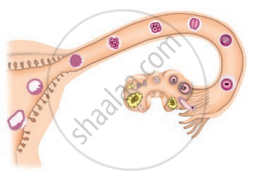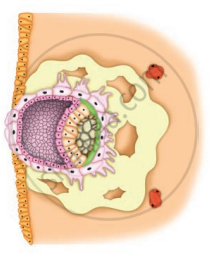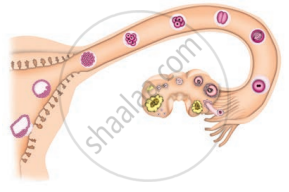Advertisements
Chapters
2: Microorganisms : Friend and Foe
3: Synthetic Fibres and Plastics
4: Materials : Metals and Non-Metals
5: Coal and Petroleum
6: Combustion and Flame
7: Conservation of Plants and Animals
8: Cell—Structure and Functions
▶ 9: Reproduction in Animals
10: Reaching the Age of Adolescence
11: Force
12: Friction
13: Sound
14: Chemical Effects of Electric Current
15: Some Natural Phenomena
16: Light
17: Stars and Solar System
18: Pollution of Air and Water
![NCERT Exemplar solutions for Science [English] Class 8 chapter 9 - Reproduction in Animals NCERT Exemplar solutions for Science [English] Class 8 chapter 9 - Reproduction in Animals - Shaalaa.com](/images/science-english-class-8_6:5f2b1b2038084cf381bfa42c826a928c.jpg)
Advertisements
Solutions for Chapter 9: Reproduction in Animals
Below listed, you can find solutions for Chapter 9 of CBSE NCERT Exemplar for Science [English] Class 8.
NCERT Exemplar solutions for Science [English] Class 8 9 Reproduction in Animals Multiple Choice Questions [Pages 47 - 48]
Sets of reproductive terms are given below. Choose the set that has an incorrect combination.
Sperm, testis, sperm duct, penis
Menstruation, egg, oviduct, uterus
Sperm, oviduct, egg, uterus
Ovulation, egg, oviduct, uterus
In humans, the development of fertilised egg takes place in the
ovary
testis
oviduct
uterus
In the list of animals given below, hen is the odd one out.
| human being | cow | dog | hen |
The reason for this is
it undergoes internal fertilisation
it is oviparous
it is viviparous
it undergoes external fertilisation
Animals exhibiting external fertilisation produce a large number of gametes. Pick the appropriate reason from the following.
The animals are small in size and want to produce more offsprings
Food is available in plenty in water
To ensure better chance of fertilisation
Water promotes production of large number of gametes
Reproduction by budding takes place in
Hydra
Paramecium
Amoeba
Bacteria
Which of the following statements about reproduction in humans is correct?
Fertilisation takes place externally
Fertilisation takes place in the testes
During fertilisation, egg moves towards the sperm
Fertilisation takes place in the human female
In human beings, after fertilisation, the structure which gets embedded in the wall of uterus is
ovum
embryo
foetus
zygote
Aquatic animals in which fertilisation occurs in water are said to be
viviparous without fertilisation
oviparous with external fertilisation
viviparous with internal fertilisation
oviparous with internal fertilisation
After fertilisation, the resulting cell which gives rise to a new individual is the
embryo
ovum
foetus
zygote
In human beings, the correct sequence of events during reproduction is
gamete formation, fertilisation, zygote, embryo
embryo, zygote, fertilisation, gamete formation
fertilisation, gamete formation, embryo, zygote
gamete formation, fertilisation, embryo, zygote
NCERT Exemplar solutions for Science [English] Class 8 9 Reproduction in Animals Very Short Answer Questions [Pages 48 - 49]
Although 2 cells called gametes fuse, the product formed is a single cell called zygote. Justify.
Stages in the life cycle of silkworm are given below. Write them in sequential order.
| Pupa | Egg | Silk moth | Caterpillar |
What is the importance of reproduction?
In markets, eggs of birds are available but never eggs of dogs, why?
The eggs of frogs do not have shells for protection, yet they are safe in water, how?
NCERT Exemplar solutions for Science [English] Class 8 9 Reproduction in Animals Short Answer Questions [Page 49]
Fill up the blanks with the terms given below :
| body | asexual | binary | single | nucleus |
Amoeba is a ______ celled organism. It reproduces by ______ reproduction.
The process of reproduction begins by the division of its ______ into two.
This is followed by the division of its ______ into two. This type of reproduction is called ______ fission.
The term metamorphosis is not used while describing human development. Why?
Mother gives birth to a baby but the baby has characters of both parents. How is this possible?
How is reproduction in Hydra different from that in Amoeba?
State whether the following statement is True or False. If false, correct the statement :
External fertilisation can occur both in water and on land.
True
False
State whether the following statement is True or False. If false, correct the statement :
The eggs of fish are covered by hard shells for protection.
True
False
State whether the following statement is True or False. If false, correct the statement :
Human egg has a head, middle piece and tail.
True
False
State whether the following statement is True or False. If false, correct the statement :
In adult human females, a single mature egg is released into an oviduct every month.
True
False
Why do only male gametes have a tail?
What does figure represent?

Observe the given figure and answer the questions that follow.

- Label A and B.
- Identify the process.
- What happens during the process and what is formed?
NCERT Exemplar solutions for Science [English] Class 8 9 Reproduction in Animals Long Answer Questions [Pages 49 - 51]
How can we say that fish exhibits external fertilisation?

After Observing above figure, answer the following,
- Read the following statements and label them in the figure.
(i) The part which produces female gametes.
(ii) The part where development of the baby takes place.
(iii) The part through which the developing embryo passes to reach the uterus. - Explain the future development of the embryo that would take place after it gets embedded in the uterus.
Hens and frogs are both oviparous exhibiting different types of fertilisation. Explain.
Observe the following figures.
 |
 |
 |
|
| (a) | (b) | (c) | (d) |
- Identify the stages (a) to (d) in figure during development of human baby.
- Arrange the stages in correct sequence of development.
- Explain the development that takes place in any one stage.
Solutions for 9: Reproduction in Animals
![NCERT Exemplar solutions for Science [English] Class 8 chapter 9 - Reproduction in Animals NCERT Exemplar solutions for Science [English] Class 8 chapter 9 - Reproduction in Animals - Shaalaa.com](/images/science-english-class-8_6:5f2b1b2038084cf381bfa42c826a928c.jpg)
NCERT Exemplar solutions for Science [English] Class 8 chapter 9 - Reproduction in Animals
Shaalaa.com has the CBSE Mathematics Science [English] Class 8 CBSE solutions in a manner that help students grasp basic concepts better and faster. The detailed, step-by-step solutions will help you understand the concepts better and clarify any confusion. NCERT Exemplar solutions for Mathematics Science [English] Class 8 CBSE 9 (Reproduction in Animals) include all questions with answers and detailed explanations. This will clear students' doubts about questions and improve their application skills while preparing for board exams.
Further, we at Shaalaa.com provide such solutions so students can prepare for written exams. NCERT Exemplar textbook solutions can be a core help for self-study and provide excellent self-help guidance for students.
Concepts covered in Science [English] Class 8 chapter 9 Reproduction in Animals are Sexual Reproduction in Animals, Mode of Reproduction in Animal, The Male Reproductive System, The Female Reproductive System, Gametogenesis, Reproduction, Fertilization in Human, Embryonic Development in Human, Embryo Formation in Viviparous and Oviparous Animals - Young Ones to Adults, Asexual Reproduction in Animal, Reproduction.
Using NCERT Exemplar Science [English] Class 8 solutions Reproduction in Animals exercise by students is an easy way to prepare for the exams, as they involve solutions arranged chapter-wise and also page-wise. The questions involved in NCERT Exemplar Solutions are essential questions that can be asked in the final exam. Maximum CBSE Science [English] Class 8 students prefer NCERT Exemplar Textbook Solutions to score more in exams.
Get the free view of Chapter 9, Reproduction in Animals Science [English] Class 8 additional questions for Mathematics Science [English] Class 8 CBSE, and you can use Shaalaa.com to keep it handy for your exam preparation.

